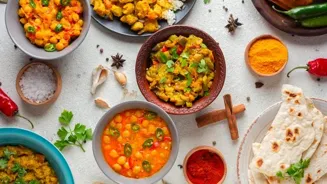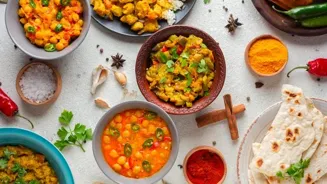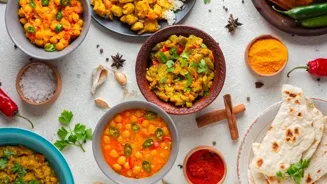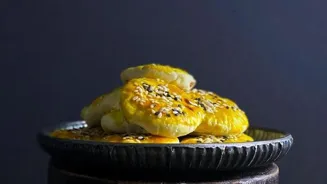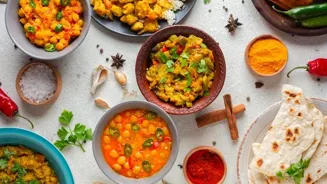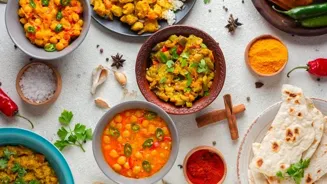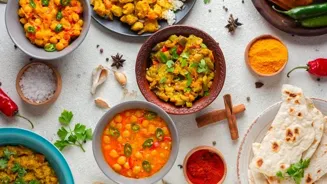Unlock the secrets of Authentic Indian Cooking with these 10 essential ingredients. Elevate your culinary adventures now!
For many Indians and those abroad fascinated by our cuisine, achieving that authentic
Indian flavour at home can feel like cracking a secret code. Forget complicated recipes and fancy equipment; the key lies in stocking your pantry with the right building blocks.
These basic ingredients, when used thoughtfully, will unlock a world of delicious possibilities, from simple dals to flavourful curries, transforming ordinary meals into culinary adventures. So, let's dive into the ten must-have ingredients that will elevate your Indian cooking game.
The Aromatic Foundation: Spices
No Indian kitchen is complete without a vibrant collection of spices. These aren't just flavour enhancers; they are the soul of Indian cuisine, each adding its own unique character to a dish.
Start with the basics: turmeric (haldi), known for its anti-inflammatory properties and warm, earthy flavour; cumin (jeera), lending a smoky and slightly bitter note; coriander (dhania), offering a citrusy and refreshing touch, and red chili powder (lal mirch), which brings the heat, and be mindful of the heat index, and adjust based on your spice level.
While whole spices offer the most intense flavour, ground versions are convenient for everyday use. Don’t forget garam masala, a blend of warming spices like cardamom, cinnamon, and cloves, typically added towards the end of cooking to add a final flourish of complexity.
For best results, store your spices in airtight containers away from direct sunlight and heat to preserve their potency. Consider buying small quantities and replenishing them frequently to ensure optimal freshness.
Experiment with different spice combinations to discover your personal flavour profiles.
Pulses and Legumes: The Protein Powerhouse
Pulses, lentils, and legumes are staple ingredients in Indian vegetarian cooking. They are an excellent source of protein, fiber, and essential nutrients, making them a healthy and filling addition to any meal. From creamy dals to hearty stews, the versatility of pulses is unmatched.
Common varieties include toor dal (split pigeon peas), moong dal (split green gram), urad dal (split black gram), chana dal (split chickpeas), and masoor dal (red lentils). Each dal has its unique flavour and texture, lending itself to different preparations.
For example, toor dal is typically used in sambar, while moong dal is often used in khichdi. Before cooking pulses, it's essential to rinse them thoroughly and soak them for a few hours, or even overnight. Soaking helps to reduce cooking time and improves digestibility.
Explore different recipes and discover your favourite ways to incorporate these nutritional powerhouses into your diet.
Rice: The Staple Grain
Rice is a dietary cornerstone in many parts of India, forming the perfect accompaniment to dals, curries, and other dishes. From fluffy basmati to short-grained sona masoori, the variety of rice available is vast and each suitable for specific reasons.

Basmati rice, with its long grains and fragrant aroma, is a popular choice for biryanis and pulaos. Sona masoori, a medium-grain rice, is a versatile option for everyday meals. Brown rice, also available easily, with its nutty flavour and higher fiber content, is a healthier alternative.
When cooking rice, rinsing it before cooking helps to remove excess starch and prevent it from becoming sticky. The water to rice ratio is crucial for achieving perfectly cooked grains.
For basmati rice, a ratio of 1:2 is typically recommended, while for other varieties, you may need to experiment to find the ideal balance. Invest in a good quality rice cooker for consistently fluffy and delicious rice every time.
Wheat Flour: The Bread Basket
Wheat flour, or atta, is the foundation of many Indian breads, including roti, chapati, paratha, and puri. These breads are an integral part of Indian cuisine, served alongside curries, dals, and vegetables.
Whole wheat flour, made from the entire wheat grain, is the preferred choice for its nutritional value and slightly nutty flavor. However, you can also find different types of atta, such as maida (refined wheat flour) and besan (gram flour), used in specific recipes.
Making the perfect roti or chapati requires practice and patience. The dough should be soft and pliable, kneaded well to develop gluten. Rolling out the dough evenly and cooking it on a hot griddle until it puffs up is an art in itself.
Experiment with different flours and techniques to master the art of Indian bread making.
Ginger-Garlic Paste: The Flavor Booster
Ginger-garlic paste is a fundamental base in most Indian dishes, imparting a pungent and aromatic flavour to curries, vegetables, and marinades. Pre-made versions are readily available in stores, but making it fresh at home is always preferable for the best flavour.
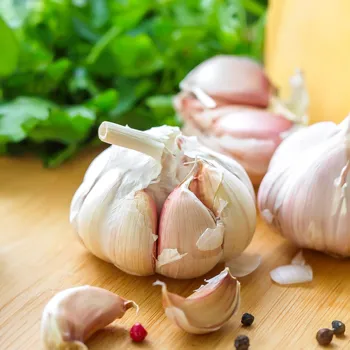
Simply blend equal amounts of ginger and garlic with a little water until you achieve a smooth paste. You can store it in an airtight container in the refrigerator for up to a week.
Using fresh ginger-garlic paste not only enhances the flavor of your dishes but also offers several health benefits, including anti-inflammatory and antimicrobial properties. Don't underestimate the power of this humble ingredient – it can truly transform the taste of your cooking.
Cooking Oil: The Medium of Flavour
The choice of cooking oil can significantly impact the flavour of your dishes. While ghee (clarified butter) is often considered the traditional choice for its rich and nutty flavour, vegetable oils like sunflower, canola, or groundnut oil are commonly used for everyday cooking.

Mustard oil, with its pungent and slightly spicy flavour, is popular in eastern India. When selecting a cooking oil, consider its smoking point and flavour profile.
Choose an oil with a high smoking point for deep-frying and an oil with a milder flavour for dishes where you want the other ingredients to shine. Experiment with different oils to discover your personal preferences and find the perfect match for your recipes.
Always store your cooking oil in a cool, dark place to prevent it from becoming rancid. Using the right cooking oil is a small detail that can make a big difference in the overall taste and quality of your food.
Tomatoes: The Tangy Touch
Tomatoes are a versatile ingredient used in many Indian dishes to add acidity, sweetness, and a vibrant red colour. They are often used as a base for curries, sauces, and chutneys.
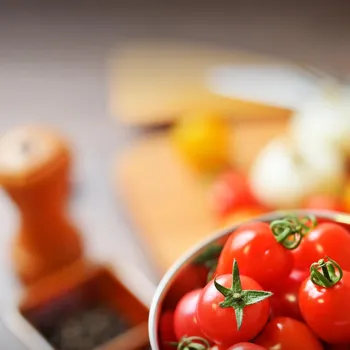
Fresh tomatoes are always the best option, but canned tomatoes, especially diced or crushed, can be a convenient substitute. When using fresh tomatoes, choose ripe and juicy ones for the most flavour. Roasting tomatoes before adding them to a dish can enhance their sweetness and depth of flavour.
Tomato paste is another useful ingredient to have on hand for thickening sauces and adding concentrated tomato flavour. A humble ingredient that is readily available and is cost effective to use.
Onions: The Sweet and Savoury Base
Onions are a foundational ingredient in most Indian dishes, providing a sweet and savoury base for curries, vegetables, and dals. They are typically sautéed until golden brown to release their flavour and add depth to the dish.
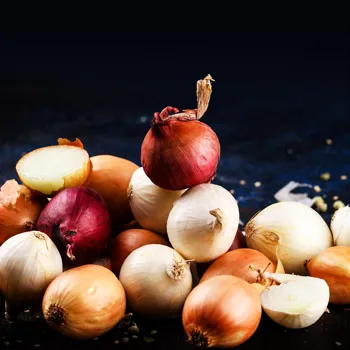
Different types of onions, such as red, yellow, and white, can be used depending on the recipe and personal preference. Caramelizing onions slowly over low heat brings out their natural sweetness and creates a rich and complex flavour.
Chopped onions can also be used as a garnish, adding a fresh and crunchy texture to the finished dish. Most humble ingredient in Indian cooking in most recipes.
Yogurt: The Creamy Coolant
Yogurt, or dahi, is an essential ingredient in Indian cooking, used in marinades, curries, and desserts. It adds a creamy texture and tangy flavour to dishes, while also acting as a tenderizer for meats and vegetables. Plain, unsweetened yogurt is the most versatile option.
Homemade yogurt is always preferable, but store-bought yogurt can also be used. Greek yogurt, with its thicker consistency, is a good substitute for sour cream. Yogurt is also used to make lassi, a refreshing Indian drink. Dahi is very important for the digestion of your food after eating.
Fresh Herbs: The Finishing Touch
Fresh herbs are the final flourish that elevates Indian dishes to another level. Coriander leaves (cilantro) are the most commonly used herb, adding a fresh and citrusy flavour to curries, dals, and garnishes.
Mint leaves are another popular choice, adding a cooling and refreshing element to chutneys, raitas, and biryanis. Curry leaves, with their unique aroma and flavour, are used in South Indian dishes. Fresh herbs should be added towards the end of cooking to preserve their flavour and aroma.
Growing your own herbs is a great way to have a constant supply of fresh ingredients. A small addition makes your food taste much better.
By stocking your pantry with these ten essential ingredients, you'll be well-equipped to embark on a delicious journey of Indian cooking.
Experiment with different recipes, explore new flavour combinations, and don't be afraid to make mistakes – that's how you'll truly learn to master the art of Indian cuisine. Happy cooking!
AI Generated Content. Glance/InMobi shall have no liability for the content